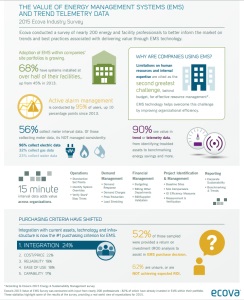by Brianna Crandall — July 27, 2015—Ecova, the total energy and sustainability management company, released a report last week with the results of its survey on calculating the value of energy management systems (EMS). The report summarizes the findings from a survey of nearly 200 multi-site companies, across multiple industries, to better understand how companies select, manage and maintain an EMS and how they utilize real-time telemetry data.
Familiar to most facilities managers, the report defines an energy management system (EMS) as a solution for remotely collecting and reporting meter data, managing operational systems and alarms, and identifying sites for improvement.
Ecova’s survey reveals that a majority of respondents — 82 percent — have EMS installed at some or all of their facilities, while 68 percent have systems installed at over half of their facilities, which is a substantial increase from 45 percent in 2013. While energy and sustainability management is becoming an essential part of daily operations for multi-site companies, limitations on human resources and internal expertise make it a challenging task.
To understand what is driving companies to utilize EMS, the survey collected information about purchasing criteria, how the systems are used, and whether the companies are achieving expected return on investment. The key findings of the Ecova report are outlined below.
Twenty four percent of companies with EMS cited integration with current assets, technology and infrastructure as the number one criteria for EMS.
As with any capital expenditure, cost is an important criterion, but companies indicated greater concern regarding EMS integration with existing systems. While there is no clear market leader in EMS brands, there appears to be a shift toward open platform technology and a move away from proprietary, closed protocol systems. Across a site portfolio, there may be multiple EMS systems under management by a facilities team.
Ninety percent of companies see value in trend or telemetry data, from identifying troubled assets to benchmarking energy savings.
In keeping with the “Big Data Awakening,” a strong majority of respondents understand that trend data analysis enables a baseline that guides a number of sustainability strategies and initiatives, from identifying wasteful, troubled assets to managing overall energy consumption.
Fifty-six percent of companies — an increase of six percent from 2013 — are also collecting and analyzing 15-minute interval data to add value to their organization. This value includes standardized set points, demand response management, back-office budgeting and financial management advantages, baseline measurement to drive efficiency gains, and overall support of sustainability initiatives.
Fifty-two percent of companies were provided a return on investment (ROI) analysis to assist in EMS purchase decision.
Multi-site companies that implement EMS systems can see initial payback in as little as 18 months. However, people and lack of processes may hinder ROI expectations by overriding system schedules and set points, which is why more than 50 percent of companies felt they did not know if they were achieving their expected ROI.
The report concludes that EMS is a growing force and that more multi-site companies are committed to energy and sustainability management, but that fully leveraging the data provided by these systems is an ongoing opportunity for many companies, especially those with hundreds or even thousands of locations and systems to manage.
Ecova has partnered with Powerhouse Dynamics, Verisae and Lucid to provide the most appropriate continuous monitoring solution to clients looking to bring insight from the data to benchmark facilities, track equipment operations in real time, diagnose issues, and assess the ROI of efficiency measures.
The report, titled Energy Management System Survey Analysis: Findings from Industry Professionals, is available for free download from Ecova. It contains Ecova’s best practice recommendations. The company also offers a detailed infographic on the report’s findings.






